Gastric-brooding Frogs are unique amphibians that are known for their extraordinary reproductive biology. These frogs are native to the rainforests of Australia.
There are two species of Gastric-brooding Frogs: the Southern and Northern Gastric-brooding Frogs. These species are fascinating due to their unique ability to incubate their eggs in their stomachs, making them the only known species of frog to do so.
Unfortunately, these fascinating creatures have been declared extinct by IUCN since the mid-1980s due to several factors, including habitat loss and the outbreak of amphibian chytrid fungus. Therefore, it is important to study and conserve these unique frogs to prevent the extinction of other species.
In this article, we will discuss everything about this frog, including its physical characteristics, habitat, behavior, and extinction. We will also tell you some interesting facts about these unique creatures.
Species Name
The Gastric-brooding frog species are two in number.
| Common Name | Scientific Name |
|---|---|
| Southern Gastric-brooding Frog | Rheobatrachus silus |
| Northern Gastric-brooding Frog | Rheobatrachus vitellinus |
Classification
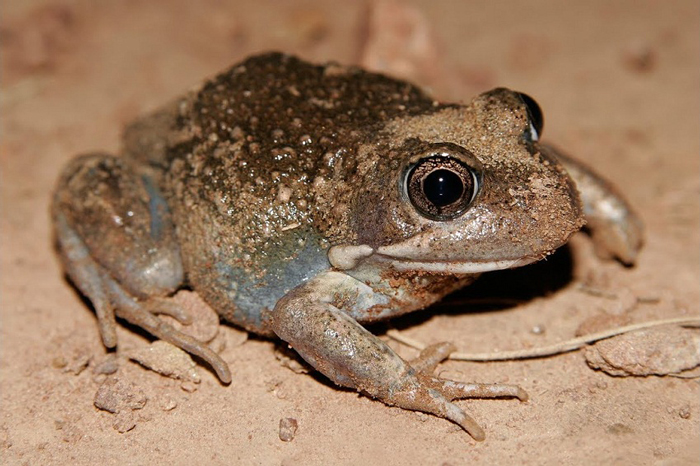
The taxonomy of the Gastric-brooding frog is as follows:
- Kingdom: Animalia
- Phylum: Chordata
- Class: Amphibia
- Order: Anura
- Family: Myobatrachidae
- Genus: Rheobatrachus
- Species: Rheobatrachus silus, Rheobatrachus vitellinus.
Physical Characteristics
Gastric-brooding Frogs, also known as Platypus Frogs, have some extraordinary physical features.
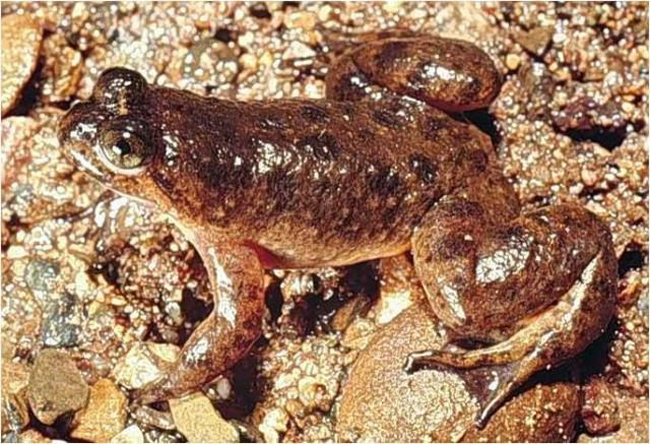
Unique Physical Features
The most striking and unique feature of the Gastric-brooding Frog is its ability to incubate its eggs in its stomach.
After fertilization, the female swallows the eggs, and the stomach secretes mucus that prevents the eggs from being digested. The eggs develop into tadpoles inside the stomach, and after six weeks, the female regurgitates fully developed froglets.
This remarkable adaptation is found in only two species of frogs, both of which are extinct now.
| Gastric-brooding frog Physical Characteristics | Description |
|---|---|
| Size | Southern: Males: 30-40mm; Females: 41-54 mm |
| Northern: Males: 50-53mm; Females: 66-79mm | |
| Coloration | Southern: The dorsal surface was brown, or olive-brown to almost black, usually with obscure darker blotches on the back |
| Northern: Pale brown with dark brown blotches on the body and limbs. | |
| Skin texture | Smooth, with granular skin on the back. The skin secreted a mucus that made them slippery and protected them from predators. |
| Unique Feature | Brooding pouch in the stomach for hatching eggs |
| Eyes | Large and bulging |
| Legs | Short and stout |
| Feet | Webbed for swimming |
| Tongue | Attached at the front of the mouth |
| Teeth | Absent |
| Vocalization | Soft chirps and grunts |
Different Species of Gastric-Brooding Frogs
These frogs have two species-
- R. silus: This was a medium-sized frog in an oval shape. It has large protruding eyes situated right after a short, blunt snout. Unfortunately, it has not been seen since 1981.
- R. vitellinus: It is almost similar to R. silus except for its larger size. It had a brown back with darker brown patches. It was one of only three Australian species known to be almost entirely aquatic.
Adaptations of Gastric-brooding Frogs to their rainforest habitats
These frogs had several adaptations to survive.
- Their small size allowed them to move easily through the dense vegetation, and their slimy skin protected them from dehydration.
- Being nocturnal, they could avoid the hot and dry daytime conditions in the rainforest.
- Furthermore, their unique reproductive biology enabled them to reproduce successfully.
Habitat and Behavior of Gastric-Brooding Frogs
The habitat of platypus frogs was rainforest areas. Rainforest ecosystems are characterized by heavy rainfall and diverse vegetation. This ecosystem is home to about 50% plant and animal species. Unfortunately, deforestation and climate change are threatening this ecosystem. Now, let’s see where the unfortunate frogs lived.
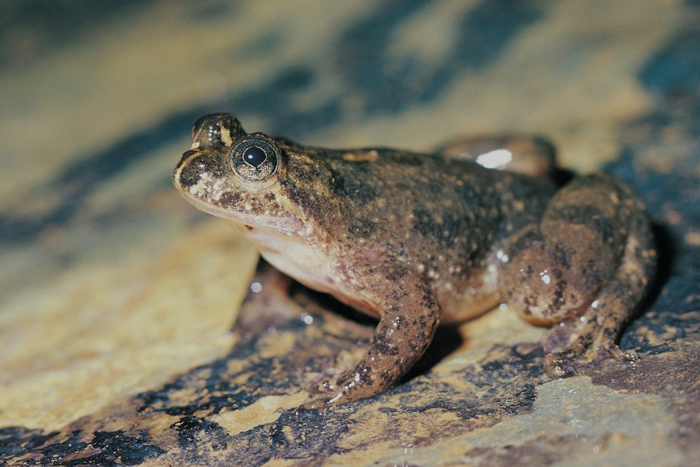
Geographical Distribution
Gastric-brooding Frogs are native to the wet subtropical rainforests of southeastern Queensland, Australia.
| Species | Found in |
|---|---|
| R. silus | Conondale and Blackall Ranges, Australia |
| R. vitellinus | Lamington Plateau, Australia |
Preferred Environment
Gastric-brooding Frogs prefer to live in rainforests, especially in areas with dense vegetation, streams, and ponds. They could also be found in swamps, marshes, and damp grasslands.
The frogs are known to inhabit regions near water sources, such as creeks and streams, where they can breed and find food. They are mostly found in areas with high rainfall and humidity levels.
Elevation Range
Among the two species, the southern was restricted between 400–800 m in the Blackall and Conondale Ranges in south-east Queensland. Contrarily, northern species had a slightly higher elevation range: 400-1000m.
Behaviors Exhibited by Gastric-Brooding Frogs
Gastric-brooding Frog behavior is interesting, including activity pattern, locomotion, social structure, communication, and predator-prey interaction.
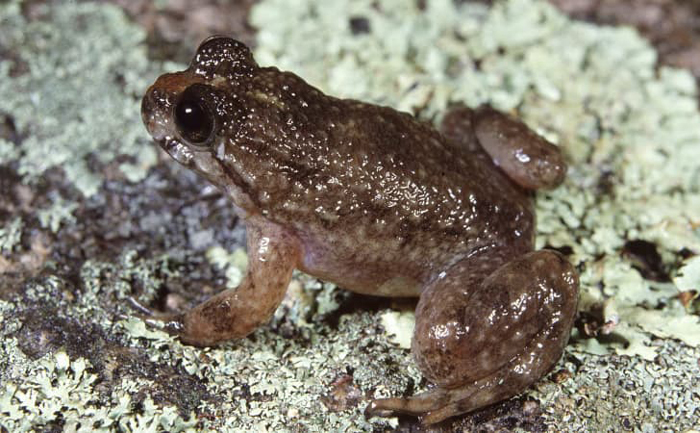
Activity Patterns
They’re primarily nocturnal and become active at night, though they may be active during the day in some situations. They tend to be most active during the breeding season when they search for mates and suitable breeding sites.
Locomotion
Gastric-brooding Frogs are primarily terrestrial and move by hopping. But they can also swim and climb when necessary. Their webbed feet and strong hind legs are well-adapted for jumping and swimming.
Social structure
Gastric-brooding Frogs are solitary creatures that typically do not interact with each other outside of the breeding season. They are known to be territorial, and males may defend breeding sites from other males.
Communication
These Frogs communicate via vocalizations, body language, and chemical signals. Males use vocalizations to attract females and defend breeding sites from other males. They also use chemical signals to mark their territories and attract mates.
Defense Mechanisms
Snakes, birds, and small mammals are some predators that attack these frogs. Frogs use various defense mechanisms to protect themselves, including camouflage and toxic skin secretions. When threatened, they may also arch their backs and raise their hind legs to display their bright warning coloration.
Mating Habit and Breeding Behavior of Gastric-Brooding Frogs
Here, we will explore their reproduction behavior, including mating season, ritual, parental habits, and many more.
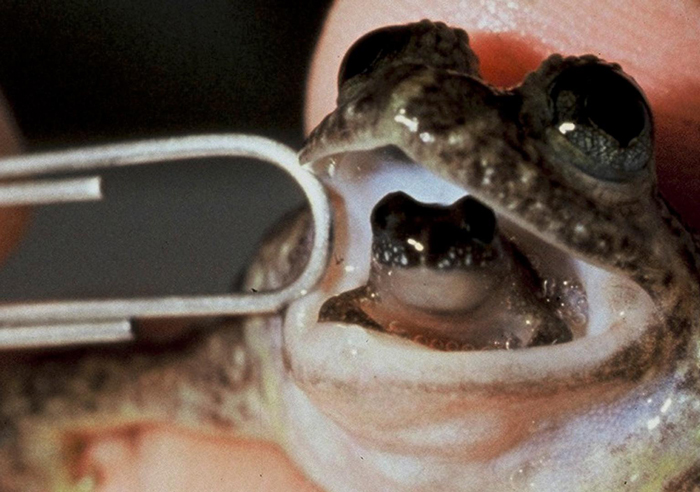
Mating Season
Gastric-Brooding frogs mate in the rainy season. During this time, the males will often call out to attract females and engage in mating rituals to establish dominance.
Mating Rituals
The mating rituals involve various calls and displays. Males make loud, distinctive calls to attract females. They also show visual displays of dominance and aggression. Sometimes, females may also perform certain displays to attract males.
Fertilization Type
Fertilization occurred internally. Male frogs deposit sperm into the female’s cloaca during mating. The fertilized eggs were then swallowed whole by the female frog, which regurgitated them into her mouth, where they hatched and developed into tadpoles.
Females carried the developing tadpoles in their stomachs, which became enlarged to accommodate them. The female provided nourishment to the developing tadpoles through the secretion of mucus, which contained nutrients and protected the tadpoles from digestive enzymes in her stomach.
Egg-Laying Habits
After fertilization, the female frog will lay her eggs. Eggs are laid in moist areas, such as under rocks, mud, or water. Females lay around 20 to 40 eggs per clutch.
Development Stages
The eggs of gastric-brooding frogs will hatch into tadpoles, which will undergo a series of developmental stages. During this time, they will undergo metamorphosis (water-dwelling tadpole >land-dwelling adult frog).
Parental Care
Their parental care is unique. The females will swallow their eggs after laying them, where eggs develop and hatch in the female’s stomach.
The tadpoles will then feed on the nutrients provided by the female until they are fully developed and ready to be born. This process is known as “gastric brooding.”
Diet of Gastric-Brooding Frogs
Gastric-brooding Frogs are carnivores whose diet mainly consists of small invertebrates, such as insects, spiders, and worms. They are opportunistic feeders and will consume whatever prey is readily available in their habitat.

Primary Food Sources
Their primary foods are insects and other invertebrates that are abundant in their rainforest habitats. They also feed on a variety of prey items, including ants, termites, beetles, and spiders, that show their predator-prey interaction.
Foraging Strategies
Gastric-brooding Frogs use a sit-and-wait foraging strategy. It means waiting for prey to come within their reach before they capture it. They are highly skilled predators, and their long sticky tongue can quickly capture their prey. Their specialized jaw structure allows them to swallow their prey whole, even if it is larger than their head.
Opportunistic Feeding Habits
They exhibit opportunistic feeding habits. They will consume everything edible that comes across them in their habitat. It is commonly observed in captive frogs and may be due to limited food availability.
Conservation Status: Extinction of Gastric-Brooding Frogs
Despite their remarkable biological features and unique breeding behaviors, the Gastric-brooding Frogs were tragically declared extinct in the mid-1980s.

Factors Leading to Decline
The frog extinction is a tragic loss to the biodiversity of the world. The species had a very limited geographical range. The primary reasons for their extinction are-
- Habitat Loss: Frog Habitats loss was the main factor that led to the decline of the platypus frogs. The rainforest ecosystem where they lived was destroyed due to logging, land development, and other human activities.
As frog habitats were destroyed, they had nowhere to go, and their population started to decline rapidly.
- Disease: In the early 1990s, a fungal disease called chytridiomycosis started spreading rapidly among frog populations around the world. This disease infects the skin of amphibians, causing them to become lethargic and unable to regulate their electrolyte balance. Chytridiomycosis was one of the biggest reasons responsible for gastric-brooding frog extinction.
Both factors had a devastating impact on their population. Consequently, by the mid-1980s, the species was declared extinct in the wild. However, efforts were made to save the species.
Efforts to Save the Species
In response to the tragic extinction of the Gastric-brooding Frogs, conservationists initiated several efforts to save the species.
- Captive breeding programs: Conservation organizations established captive breeding programs trying to save the species from extinction. These programs aimed to breed and raise frogs in a controlled environment, aiming to reintroduce them into the wild.
One notable program was led by the Queensland Parks and Wildlife Service in the 1980s and early 1990s. They successfully bred the Southern Gastric-brooding Frog and raised tadpoles to adulthood. However, despite these efforts, the species eventually went extinct.
- DNA Technology: Another innovative approach was the use of DNA technology, specifically somatic cell nuclear transfer. This involved taking genetic material from extinct frogs and implanting it into the eggs of related species. Thus, create embryos that carry the genetic material of the extinct species.
While this approach showed promise, it was not successful in bringing back the extinct frogs. Technical challenges and ethical concerns surrounding the use of genetic material from extinct species hindered its progression.
Challenges in Conservation
Conservation failed because of failing to the following challenges:
- Legal protections: Despite legal protections, including the designation of the frog as critically endangered, the species continued to decline due to habitat loss and disease.
- Habitat restoration: Efforts to restore the gastric-brooding frog habitat have been complicated by the unique requirements of the species. For instance, its dependence on leaf litter and the presence of specific soil microbes.
Lessons Learned From the Extinction of Gastric-brooding Frogs
- Habitat preservation and restoration for endangered species is necessary.
- The success of these programs demonstrates the potential for conservation efforts to save species from extinction.
- Advances in DNA technology have enabled scientists to study extinct species and potentially revive them through de-extinction efforts.
- The tragic loss of the platypus frog emphasizes the need for continued research and conservation efforts to prevent further extinctions in the future.
Interesting Facts
Here are some interesting facts about Gastric-brooding Frogs:
- These are the only frogs that incubate their eggs in their stomachs.
- After swallowing their eggs, the females stop producing hydrochloric acid and other digestive juices, which allows the eggs to develop inside their stomachs.
- The platypus frogs went extinct in the 1980s, and no one has seen them in the wild since then.
- In 2013, scientists announced that they had successfully cloned embryos of the extinct frog species using preserved DNA. It raised hopes for the possibility of bringing them back to life someday through de-extinction techniques.
Conclusion
The Gastric-brooding Frogs were fascinating creatures with unique reproductive biology and behaviors. Unfortunately, their extinction serves as a reminder of the devastating impact of habitat loss, disease, and other human activities on wildlife.
Research institutions should continue researching frog ecology and implementing conservation efforts to prevent the extinction of other species and preserve biodiversity. By raising awareness and taking action, we can make a difference in protecting the natural world and ensuring a sustainable future for all living organisms.
For individuals interested in learning more about Gastric-brooding Frogs and their unique behaviors, we recommend reading scientific publications on amphibian ecology, reproductive biology, and conservation biology.
Additionally, numerous books and articles discuss the importance of biodiversity conservation and the impacts of human activities on wildlife. Let us strive toward a sustainable future for all living organisms.

Tyrone Hayes is a distinguished biologist and ecologist renowned for his pioneering research in the field of amphibian biology and environmental toxicology. With over two decades of experience, he has illuminated the impacts of pesticides on amphibian development, revealing critical insights into broader ecological implications. Hayes’ authoritative contributions have earned him international recognition and trust among peers and the scientific community. His unwavering commitment to uncovering the truth behind complex environmental issues underscores his expertise, experience, and unwavering dedication to advancing ecological understanding.
